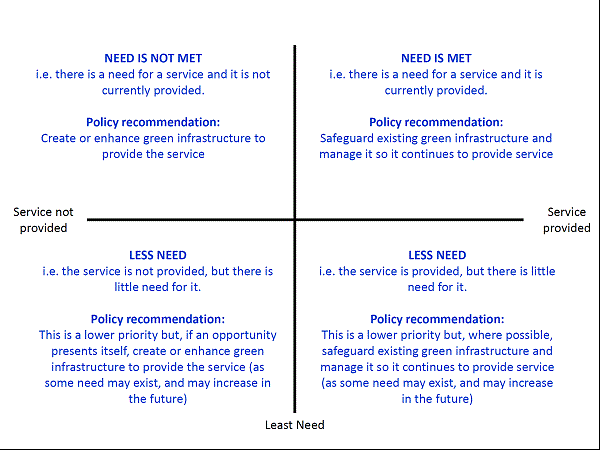How can we do it?
Actions to take
- Review the recommended general actions.
- Join relevant networks and access more specific information portals to learn more and to keep up to date. For example:
- The Ecosystems Knowledge Network which aims to support the development of an ecosystems approach through building awareness, supporting action and the process of sharing experience.
- Compilation of tools and guidance to support the development of Sustainable Urban Drainage interventions.
- Compilations of resources for Green Infrastructure Strategy Development1.
- The Town and Country Planning Association (TCPA) Green Infrastructure Partnership. A 2013 briefing document from the Royal Town Planning Institute (RTPI) identifies links between green infrastructure and the planning systems in England, Scotland, Wales and Northern Ireland.
- The work of voluntary sector organisations such as The Conservation Volunteers, Groundwork, Woodland Trust, and local community forests like Greenwood Community Forest and Mersey Forest, all of whom are also highly experienced in working with local communities
- Understand more about the arguments for why green infrastructure is relevant to a range of decision-makers working in different areas of policy and practice2.
- Get ideas from existing case studies, such as those listed in the previous section. The Environment Agency has additional case studies.
- Build a local evidence base using a range of available tools and guidance3. This will help in the process of considering how and where green infrastructure can be established within local communities. The ClimateJust maps can be used to identify where there is specific need for green infrastructure and related green and blue spaces. This can consider the potential for, and likely severity of, climate and extreme weather impacts but importantly should also consider places where there are high levels of social vulnerability or climate disadvantage.
- Think about the building stock which houses vulnerable communities in your area and the green infrastructure adaptation measures which might be appropriate for them.
- Think about what can be adopted in the wider community in order to deliver benefits without the need for individual action by householders.
- Remember that green infrastructure does not always need to be at the building scale and neighbourhood initiatives can benefit multiple households in the local area.
- Consider how and why green infrastructure solutions may be resisted by local communities and how concerns might be overcome.
- Think about possible drawbacks of green infrastructure initiatives. For example, do members of the community have concerns about the adoption of certain types of green space interventions which need to be addressed? Are there potential negative impacts which need to be managed? Are there ways to involve local communities in evidence building and the assessment of the success of schemes?
- Involve local communities in establishing greening initiatives. See guidance for local communities to help them to establish local green spaces.
- Consider other possible negative outcomes from interventions and how they can be managed. This will include planning for maintenance of green infrastructure and considering how interventions themselves are resilient to future climate changes.
- Address issues of environmental justice by determining how your local area meets existing green infrastructure standards.
- Natural England’s Accessible Natural Greenspace Standards (ANGSt) and associated guidance provides a basis for identifying need and the extent of current provision4.
- Other assessment methodologies which consider wider green infrastructure functions are also helpful, such as Mersey Forest’s green infrastructure planning framework (see Figure 2) which can be combined with a mapping approach5,6.

Figure 2: Framework for assessing ecosystem service provision and need linked to policy recommendations7
References
- Natural England (2014) Green Infrastructure Signposting
- Defra (2010) What nature can do for you. A practical introduction to making the most of natural services, assets and resources in policy and decision making
- The Mersey Forest and the University of Manchester (2011). STAR tools: surface temperature and runoff tools (for assessing the potential of green infrastructure in adapting urban areas to climate change)
- Natural England (2010) ‘Nature Nearby’ Accessible Natural Greenspace Guidance
- The Mersey Forest (2010). Liverpool Green Infrastructure Strategy. Commissioned by Liverpool City Council Planning Business Unit and Liverpool Primary Care Trust.
- Butlin et al (2011) The Value of Mapping Green Infrastructure
- Adapted from The Mersey Forest (2010). Liverpool Green Infrastructure Strategy. Commissioned by Liverpool City Council Planning Business Unit and Liverpool Primary Care Trust.

Built by:

© 2014 - Climate Just
Contact us
